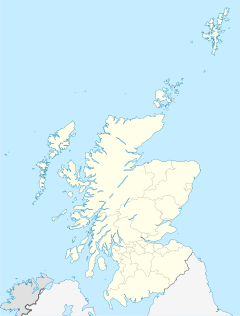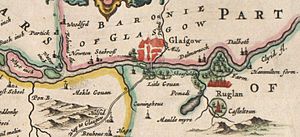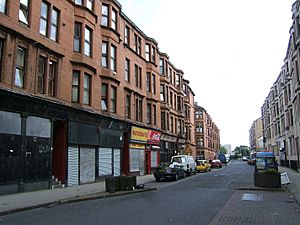Govan facts for kids
Quick facts for kids Govan
|
|
|---|---|
 Govan Town Hall |
|
| Area | 1.63 km2 (0.63 sq mi) |
| Population | 5,860 (2015) |
| • Density | 3,595/km2 (9,310/sq mi) |
| OS grid reference | NS555655 |
| • Edinburgh | 45 mi (72 km) E |
| • London | 346 mi (557 km) SSE |
| Council area | |
| Lieutenancy area |
|
| Country | Scotland |
| Sovereign state | United Kingdom |
| Post town | GLASGOW |
| Postcode district | G51 |
| Dialling code | 0141 |
| Ambulance | Scottish |
| EU Parliament | Scotland |
| UK Parliament | |
| Scottish Parliament | |
Govan (pronounced GUV-un) is a cool district in southwest Glasgow, Scotland. It's about 4 kilometers (2.5 miles) west of Glasgow city centre. You can find it on the south side of the River Clyde, right across from Partick.
Long ago, Govan was a very important Christian center. This was during the early medieval period, when it was part of the Kingdom of Strathclyde. Amazing stone sculptures, called the Govan Stones, were made here around that time.
Govan was also a place where people could cross the river. Later, it became known for making textiles and coal mining. But its biggest industry became shipbuilding in the 1800s. Govan became a large town (called a burgh) in 1864. It was one of the biggest in Scotland before it became part of Glasgow in 1912.
Contents
Govan's Long History
Early Days of Govan
Archaeologists have found signs of an old Christian church in Govan. They found two Christian burials that are about 1,500 years old. This makes Govan one of the oldest known Christian sites in the area.
Govan was likely part of a kingdom ruled from Dumbarton Castle. This kingdom was called Alt Clut. After Vikings attacked Dumbarton Rock in 878, Govan became a major center for the Kingdom of Strathclyde.
A sarcophagus (a stone coffin) was found in the churchyard in 1855. It has beautiful carvings from the 10th or 11th centuries. Some people think it might have held the body of an early king, Constantine.
The name Govan might come from an old language called Cumbric. In Scottish Gaelic, Govan is Baile a' Ghobhainn, which means "the smith's town".
The first records of Govan are about its Christian church. In 1136, King David I gave the church and land to Glasgow Cathedral. The Govan Old Parish Church has been rebuilt several times. Inside, you can see some of the best early Christian stones in the UK.
By the 1500s, there were many coal mines around Govan. As the village grew, new jobs like weaving, pottery, and farming started up.
Growing into a Town
In the early 1800s, Govan started to look less like a village. New industries and factories, like dye works and silk mills, began to appear.
To help trade, the River Clyde was made deeper in 1759. Docks and quays were also built. This helped shipbuilding become a very important industry.
By the 1860s, Govan needed its own local government. So, in 1864, it became a burgh. At that time, it was the fifth-largest burgh in Scotland. Areas like Ibrox and Drumoyne were part of Govan.
Govan grew very quickly in the late 1800s. Its population went from 9,000 in 1864 to 95,000 by 1907. In 1912, Glasgow officially took over Govan.
There used to be a large hill in Govan called the Doomster or Moot Hill. It was removed in the early 1800s. Some people think it was an ancient burial mound. Others believe it was a Norman motte, a type of castle mound.
Govan in Modern Times
Govan has often been seen as a working-class area. People there have traditionally supported the Labour Party. However, the Scottish National Party (SNP) has also been popular. Famous politicians like Margo MacDonald and Nicola Sturgeon have won elections in Govan.
The area has faced challenges, partly because new housing was built in the 1930s. This housing was for people moving from crowded areas like The Gorbals.
Every year, on the first Friday in June, Govan celebrates the Govan Fair. It's a fun local tradition!
Govan's Economy
Govan was once a global center for shipbuilding on the River Clyde. In 1841, Robert Napier started building iron ships in Govan. His company even built ships for the Royal Navy.
Another big shipbuilding company was Fairfield Shipbuilding and Engineering Company Ltd. It started in the 1860s. This company continued until 1965.
In 1966, Fairfield and other major shipyards on the Clyde joined together. They formed a group called Upper Clyde Shipbuilders (UCS).
In 1971, UCS faced financial trouble. Instead of going on strike, workers decided to have a "work-in." They kept building ships to show that the yards could still be successful.
Later, the government took over Govan's shipyard in 1977. It became part of British Shipbuilders. In the 1980s, many government-owned companies were sold to private businesses.
A Norwegian company called Kværner bought the Govan shipyard in 1988. It was renamed Kvaerner Govan.
In 1999, GEC's Marconi Marine bought the yard. Later, Marconi Marine became part of BAE Systems. Today, the shipyard is known as BAE Systems Surface Ships.
Famous Ships Built in Govan
Many famous ships were built in Govan. Here are just a few examples:
- PS Vanguard (1843)
- PS Scotia (1861)
- HMS Northampton (1876)
- HMS Nelson (1876)
- HMS Curacoa (1878)
- SS Arizona (1879)
- RMS Campania (1891)
- RMS Lucania (1893)
- HMS Venus (1895)
- HMS Diana (1895)
- HMS Highflyer (1898)
- HMS Hermes (1898)
- RMS Empress of Britain (1906)
- RMS Empress of Ireland (1906)
- HMS Indomitable (1907)
- HMS New Zealand (1911)
- HMAS Sydney (1912)
- RMS Empress of Russia (1913)
- RMS Empress of Asia (1913)
- SS Calgarian (1913)
- HMS Valiant (1914)
- HMS Renown (1916)
- RMS Empress of Canada (1922)
- SS Athenia (1922)
- Aorangi (1922)
- TSS Tuscania (1923)
- SS Letitia (1924)
- HMS Berwick (1926)
- HMS Norfolk (1928)
- RMS Empress of Japan (1930)
- HMS Delight (1932)
- HMS Liverpool (1937)
- HMS Phoebe (1937)
- HMS Howe (1940)
- HMS Implacable (1942)
- HMS Theseus (1944)
- HMS Blake (1945)
- SS Karanja (1948)
- TS Oxfordshire (1955)
- TS/SS Empress of Britain (1956)
- HMS Fife (1964)
- HMS Antrim (1967)
- USNS Harkness (1968)
- Jervis Bay (1969)
- USNS Chauvenet (1970)
- Pacific Peace (1981)
- MV Selkirk Settler (1983)
- MV Saskatchewan Pioneer (1983)
- Sir Charles Parsons (1985)
- MV Norsea (1986)
- MV Havis (1992)
- Sea Launch Commander (1996)
- RFA Wave Ruler (2003)
- RFA Mounts Bay (2004)
- HMS Daring (2006)
- HMS Dauntless (2007)
- HMS Diamond (2007)
- HMS Dragon (2008)
- HMS Defender (2009).
- HMS Duncan (2010)
Getting Around Govan
Govan has its own Subway stations. These are Govan, Ibrox, and Cessnock.
There used to be a train station in Govan. It opened in 1868 but closed to passengers in 1921.
Many bus services run through Govan. They can take you to Glasgow City Centre and other places in Renfrewshire.
Sports in Govan
Govan is right next to Ibrox, which is home to the famous Scottish football team Rangers F.C.. Their stadium, Ibrox Stadium, has a stand named after Govan.
Govan also has its own local football team, Benburb F.C.. They play in the Junior league.
In the past, Govan had other sports venues. These included White City Stadium and Albion Greyhound Stadium. Both of these have now been taken down.
Govan in the Media
Govan has its own community radio station called Sunny Govan Radio. You can listen to it on 103.5FM in Glasgow. It talks about local news and plays different kinds of music.
Govan has also had several local newspapers over the years. These included the Govan Chronicle and the Govan Press.
Religion in Govan
The main church in Govan is the Govan Old Parish Church. It was dedicated to a saint named Constantine.
In 1577, the University of Glasgow was given control of the church. The head of the University became the minister. The church has been rebuilt several times, most recently in the late 1800s.
Famous People from Govan
Many interesting people have come from Govan:
- Mary Barbour - She lived in Govan and helped organize the Glasgow Rent Strikes.
- Isabella Elder - A kind person who gave Elder Park and a library to the people of Govan.
- Leo Blair (senior) - The father of former Prime Minister Tony Blair. He grew up in Govan.
- Sir Alex Ferguson - A very famous football manager who led Manchester United to many victories.
- James Hedderwick - A poet and newspaper owner who was born and raised in Govan.
- James Kelman - A well-known writer.
- George MacLeod - A minister of the Church of Scotland who founded the Iona Community.
- Belle Moore - An Olympic Gold Medalist.
- Jimmy Reid - A famous trade union leader.
- Johnny Beattie - A popular actor and comedian.
- Bill Martin - A songwriter and music producer.
- Dame Elish Angiolini - A top lawyer in Scotland, who grew up in Govan.
- Jim Craig - A famous Celtic football player.
Images for kids





